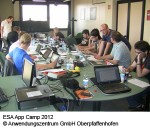Friday, June 28th, 2013
The biomass of the northern hemisphere’s forests has been mapped with greater precision than ever before thanks to satellites, improving our understanding of the carbon cycle and our prediction of Earth’s future climate. Accurately measuring forest biomass and how it varies are key elements for taking stock of forests and vegetation. Since forests assist in
Tuesday, May 7th, 2013
ESA’s Earth Observation Programme Board has selected ‘Biomass’ to become the seventh Earth Explorer mission. The innovative satellite aims to map and monitor one of Earth’s most precious resources.
Tuesday, May 7th, 2013
Those who need satellite data for a wide range of applications, from mapping sea ice and tracking maritime traffic to monitoring geohazards over land, are eagerly awaiting the launch of Sentinel-1. ESA is helping users get ahead of the game by offering test data and simulated images.
Tuesday, April 30th, 2013
International development banks often invest in regions where projects can be difficult to monitor and evaluate. Earth-observing satellites are proving to be important tools for the development sector. From 800 km high, satellites enable objective observations consistently over space and time. They can detect changes in land cover, monitor water quality and identify pollutants, evaluate
Tuesday, March 12th, 2013
Europe’s new age of satellite navigation has passed a historic milestone – the very first determination of a ground location using the four Galileo satellites currently in orbit together with their ground facilities. This fundamental step confirms the Galileo system works as planned.
Monday, March 11th, 2013
Satellites map changes in Earth’s surface caused by earthquakes but never before have sound waves from a quake been sensed directly in space – until now. ESA’s hyper-sensitive GOCE gravity satellite has added yet another first to its list of successes.
Wednesday, February 20th, 2013
For decades, scientists have disagreed about whether the sea is higher or lower heading north along the east coast of North America. Thanks to precision gravity data from ESA’s GOCE satellite, this controversial issue has now been settled. The answer? It’s lower.
Wednesday, February 20th, 2013
Good news for Europe’s Global Monitoring for Environment and Security programme: the European Council has secured the programme’s EU funding through 2020. The multiannual financial framework – MFF – is a seven-year plan for the EU’s budget. On 8 February, European heads of State and government agreed to include GMES in the 2014–20 MFF.
Wednesday, February 13th, 2013
An international team of scientists using new measurements from ESA’s ice mission has discovered that the volume of Arctic sea ice has declined by 36% during autumn and 9% during winter between 2003 and 2012.

Thursday, February 7th, 2013
Following the great success of the first ESA App Camp last year, Anwendungszentrum GmbH Oberpfaffenhofen will organise the second round of the app developer lab for the European Space Agency from 3 to 10 June 2013. Based on their previous works, 20 participants will be invited to ESA’s ESRIN location in Frascati (near Rome), Italy